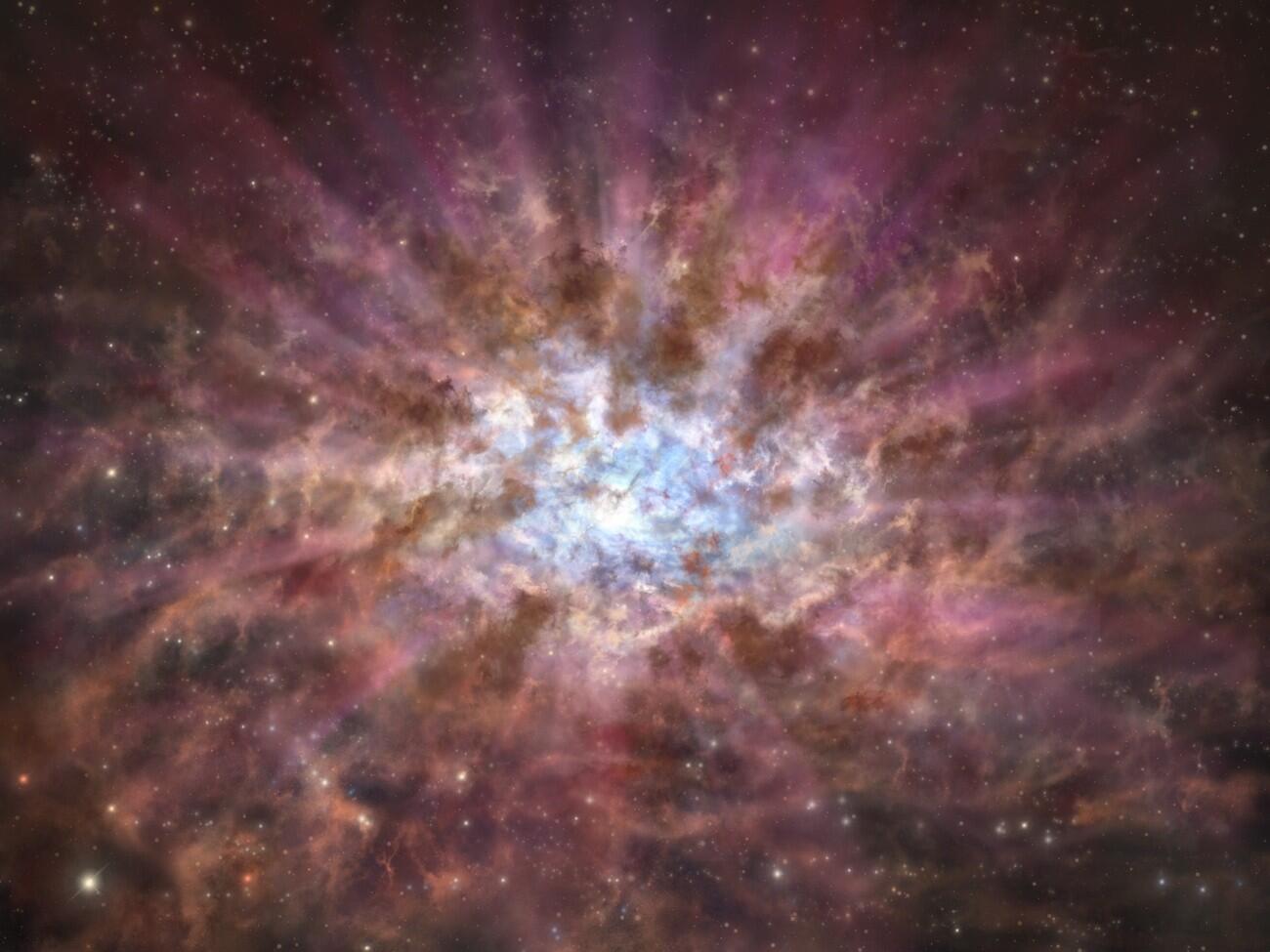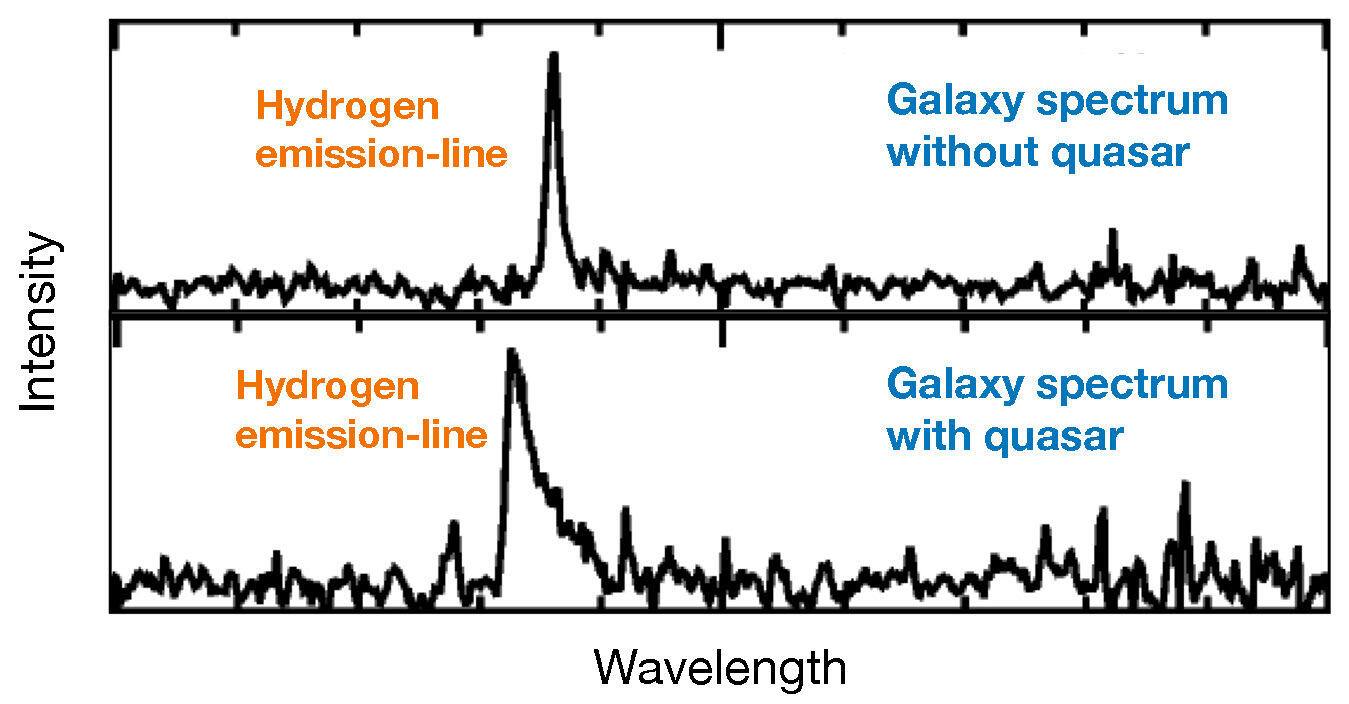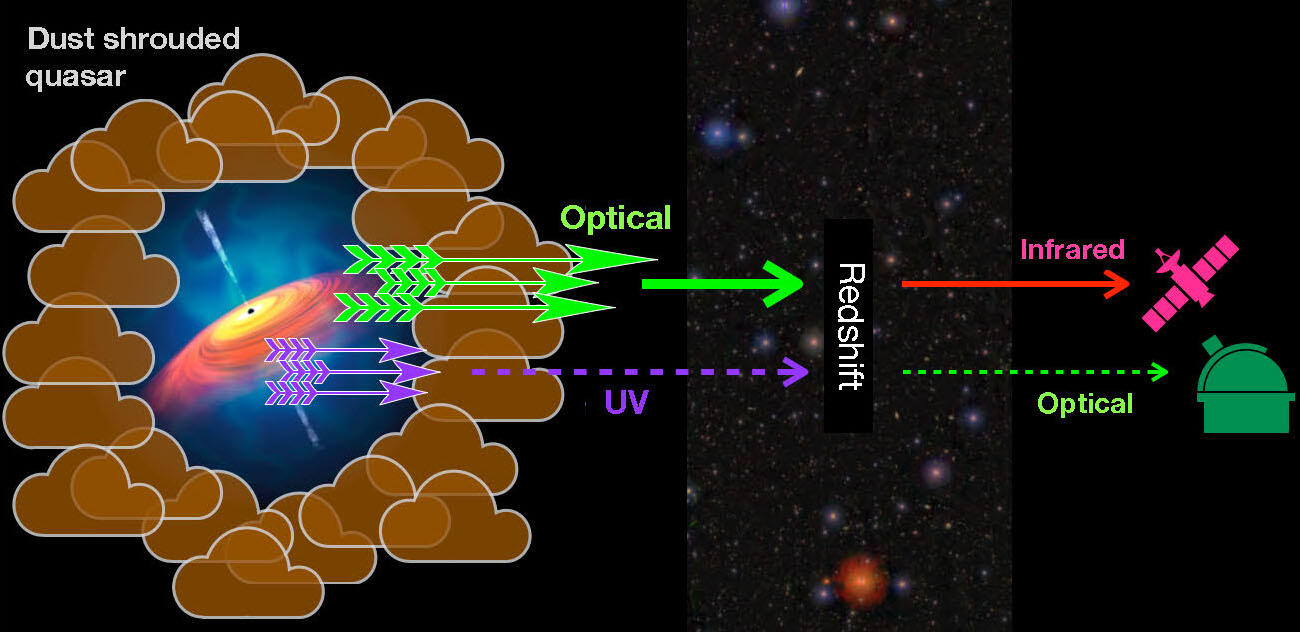Astronomers have discovered "dust-shrouded supermassive black holes" in the early Universe, less than one billion years after the Big Bang — a type of object that had previously escaped detection. An international research team, including scientists from Ehime University and the National Astronomical Observatory of Japan (NAOJ), first identified candidate galaxies with the Subaru Telescope and then confirmed with the James Webb Space Telescope (JWST) that they host supermassive black holes shining as quasars while consuming surrounding matter. This marks the first discovery of such hidden but bright quasars in the early Universe, revealing that bright quasars are at least twice as common at that time as previously thought.

Figure 1: An artist’s impression of a dust-shrouded quasar in the early Universe. (Credit: NAOJ)
Background
In the present Universe, 13.8 billion years after the Big Bang, almost all galaxies host supermassive black holes at their centers, with masses exceeding millions of times that of the Sun. These black holes remain dormant most of the time, but when they accrete surrounding matter, they emit strong radiation and become powerful objects called quasars. The intense radiation from a quasar is believed to significantly affect the growth and evolution of its host galaxy by expelling the gas inside the galaxy. As galaxies trace the evolution of the visible Universe, understanding supermassive black holes is crucial for deciphering how the Universe was shaped into the form we see today.
Despite the key role supermassive black holes play in the Universe, there remains a fundamental mystery as to how they ever formed. Many supermassive black holes have already been found as early as 1 billion years after the Big Bang, which implies that their formation must have occurred even earlier. For this reason, extensive searches for quasars have targeted the early epoch, sometimes called the "Cosmic Dawn," when the Universe was less than 1 billion years old. An important clue to understanding their formation mechanism is their number density-that is, the number of supermassive black holes per unit volume of space. If the number is high, they must have formed relatively frequently and widely, possibly as remnants of first-generation stars. Conversely, a low number density would suggest formation under special conditions, such as the direct collapse of massive objects due to self- gravity, forming initial black holes.
When a supermassive black hole is active as a quasar, it shines so brilliantly that it can be detected even at great distances, corresponding to earlier times in the Universe. In quasar light, we see a "broad emission line," broadened by the Doppler effect from gas orbiting at high velocity around the central black hole (Figure 2). Detecting such a broad emission line is a definitive sign of an active supermassive black hole in a galaxy.

Figure 2: Examples of galaxy spectra. The graphs show light intensity versus wavelength. A sharp peak in the spectrum, called an "emission line," appears when hydrogen emits light at a specific wavelength. In a normal galaxy (top), emission lines are narrow. In a galaxy hosting a quasar (bottom), fast-moving gas near the black hole broadens the lines. (Credit: Yoshiki Matsuoka/NAOJ)
Earlier work by research groups led by U.S. and European researchers used this method to discover quasars at the Cosmic Dawn. The research team in this study joined the effort, using the Subaru Telescope, and has discovered more than 200 quasars.
However, conventional surveys face limitations due to observational technology: quasars were identified by using the ultraviolet light they emit—which appears as visible light from Earth (Figure 3)—as a marker. Ultraviolet light is easily absorbed by dust, and many galaxies contain a substantial amount of dust. When a quasar resides in such a galaxy, its ultraviolet light is largely absorbed and does not reach us. This has led to the suspicion that quasars discovered in conventional surveys represent only a fraction of the true population, with many more hidden by dust.
Observing Hidden Quasars
The research team focused on the most luminous galaxies discovered in the wide-area survey conducted with Hyper Suprime-Cam on the Subaru Telescope (HSC-SSP). These galaxies were initially found while searching for quasars, but since no broad emission lines were detected at the time, they were not considered to be quasars. Still, signs of a powerful energy source had led the team to suspect for more than 10 years that hidden quasars might be present. The launch of JWST was a game changer. For the first time, the team could observe visible light from these galaxies—which reaches Earth as infrared light—allowing them to see through dust that would block ultraviolet light (Figure 3).

Figure 3: Schematic diagram showing how a quasar hidden by dust is observed. Light from a quasar in the early Universe is stretched by cosmic redshift, so ultraviolet light reaches Earth as visible light and visible light reaches Earth as infrared. When a quasar is covered by dust, ultraviolet light is absorbed and cannot escape, but infrared observations can capture the visible light that passes through the dust. Detecting such faint infrared light from early quasars required observations with JWST. (Credit: Yoshiki Matsuoka/NAOJ)
Observations were carried out with the NIRSpec spectrograph onboard JWST from July 2023 to October 2024, targeting 11 of the most luminous galaxies discovered by the Subaru Telescope. Seven of them clearly show broad emission lines, a telltale sign of a quasar (Figure 4). This confirms the presence of dust-shrouded quasars. These are the first dust-obscured luminous quasars discovered at the Cosmic Dawn (Note 1).

Figure 4: Galaxies observed in this study. The left panels show images taken by the Subaru Telescope at the time of discovery. The right panels show spectra obtained from follow-up observations with JWST, capturing the Hα emission line of hydrogen at a wavelength of 650 nanometers. In the seven galaxies on the left, hydrogen gas is orbiting rapidly around a supermassive black hole, producing a broadened emission line due to the Doppler effect. In the remaining four galaxies, the emission line is narrower, and the presence of a supermassive black hole could not be confirmed. (Credit: Yoshiki Matsuoka/NAOJ/NASA )
A closer look at the spectra revealed that these quasars emit energy equivalent to a few trillion Suns and are powered by black holes with masses of a few billion Suns. These values are comparable to ordinary, unobscured quasars known from the Cosmic Dawn. The team also found that dust absorbs about 70% of the visible light and nearly all (99.9%) of the ultraviolet light from these quasars, which explains why they were missed in previous surveys.
By comparing the number densities of quasars, the team concluded that dust-obscured quasars are at least as common as the previously known, conventional quasars. This means that the number of bright quasars in the early Universe is at least twice as high as previously thought.
Dr. Yoshiki Matsuoka of Ehime University, who led this study comments:
"This discovery was only possible with the unique combination of two powerful telescopes. The Subaru Telescope’s wide and sensitive survey allowed us to spot rare, luminous galaxies, and JWST was able to catch the faint infrared light from the hidden quasars. This shows how effective the approach of 'Discover with Subaru Telescope, explore with James Webb' can be."
Future prospects
The team foresees two main directions for future research. First, they plan to follow up on the obscured quasars to see whether they differ fundamentally from conventional ones. JWST spectra contain emission lines from various elements, revealing the physical conditions near the black holes. They also plan to use the ALMA telescope to study the host galaxies in detail.
Second, the team aims to expand the search for hidden black holes to a broader population of galaxies, including less luminous ones, in order to reveal the full population of supermassive black holes in the early Universe. They already have a new JWST program approved, and the upcoming observations are scheduled to start early next year.
These results appeared as Matsuoka et al. "SHELLQs. Bridging the Gap: JWST Unveils Obscured Quasars in the Most Luminous Galaxies at z > 6" in the Astrophysical Journal on July 14, 2025.
(Note 1) A few possible candidates for dust-obscured quasars at the Cosmic Dawn have been reported previously. However, they remain inconclusive because no broad emission line was detected. Recent JWST observations discovered numerous new objects called "Little Red Dots," many of which show broad emission lines. These are thought to host black holes but are much fainter than the quasars previously discovered in the early Universe. In contrast, this study has uncovered the first examples of supermassive black holes at the Cosmic Dawn that are as luminous as the conventional quasars, but have been dimmed by their surrounding dust.


